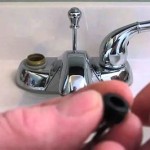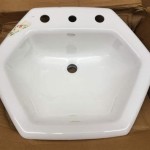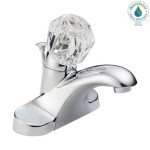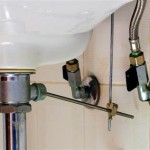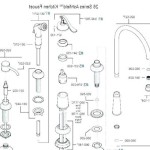Understanding the Delta Bathroom Sink Cartridge
The Delta bathroom sink cartridge is a crucial component within Delta faucets, responsible for controlling the flow and temperature of water. It is essentially the faucet's internal mechanism, acting as a valve to mix hot and cold water to achieve the desired temperature and pressure. A malfunctioning or worn-out cartridge can lead to drips, leaks, and inconsistent water temperature, necessitating replacement to restore the faucet's optimal performance.
The cartridge is typically a cylindrical component made of plastic, brass, or a combination of materials. It contains internal seals and passages that direct the water flow. Delta cartridges are designed to be relatively easy to replace, often allowing homeowners to perform the repair themselves with basic tools, saving on plumbing service costs. However, identifying the correct cartridge model for a specific Delta faucet is paramount to ensure proper functionality and prevent further damage.
Delta Faucet Company has manufactured and distributed a wide array of faucet models over many years, each potentially utilizing a different cartridge design. Understanding the nuances of these cartridges, how they operate, and how to identify the correct replacement are essential for maintaining a properly functioning Delta bathroom sink faucet. The following sections will delve deeper into these aspects.
Identifying the Correct Delta Bathroom Sink Cartridge
Accurately identifying the correct replacement Delta bathroom sink cartridge is the first and arguably most important step in the repair process. Installing the wrong cartridge can lead to improper faucet operation, leaks, and potential damage to the faucet body. Several methods can be employed to ensure the correct cartridge is identified.
One of the most reliable methods is to locate the faucet's model number. This number is generally found printed on the faucet itself, often underneath the sink, on the spout, or on the faucet handle. It may also be found in the original product documentation or packaging. Once the model number is known, it can be used to search Delta's online parts catalog or consult with a plumbing supply store to identify the corresponding cartridge. Delta's website often provides detailed diagrams of their faucets and parts lists, making the identification process easier.
Another method, useful when the model number is unavailable, involves visually inspecting the existing cartridge. Carefully remove the old cartridge from the faucet following the manufacturer's instructions. Pay close attention to its shape, size, and any markings or numbers present on the cartridge body. Compare these characteristics with images and descriptions of Delta cartridges available online or in catalogs. Note any unique features, such as the number of O-rings, the presence of specific cutouts, or the color of the plastic components. This visual comparison can often narrow down the possibilities and lead to the correct identification.
If neither the model number nor visual inspection provides a definitive answer, consulting with a plumbing professional or contacting Delta's customer service department is recommended. These experts can often identify the correct cartridge based on a description of the faucet and the issues being experienced. Providing clear photographs or videos of the faucet and the old cartridge can also be helpful in this process. It is always preferable to seek expert assistance than to risk installing the wrong cartridge and potentially causing further damage.
Common Issues and Troubleshooting
Several issues can arise with Delta bathroom sink cartridges, indicating the need for replacement or repair. Some of the most common problems include dripping faucets, leaks around the base of the faucet, reduced water flow, and inconsistent water temperature.
A dripping faucet is often the first sign of a worn-out or damaged cartridge. Over time, the internal seals within the cartridge can degrade, allowing water to bypass the valve and drip from the spout. This dripping can be constant or intermittent, and it can waste significant amounts of water over time. In some cases, disassembling the cartridge and cleaning the seals can temporarily resolve the issue. However, replacement is usually the more reliable and long-term solution.
Leaks around the base of the faucet can also be caused by a faulty cartridge. These leaks may occur when the faucet is turned on or off, or they may be constant. The water can seep down the faucet body and onto the countertop or into the cabinet below, potentially causing water damage. Such leaks often indicate that the cartridge housing or the O-rings that seal the cartridge to the faucet body have deteriorated.
Reduced water flow can sometimes be attributed to a clogged or partially obstructed cartridge. Mineral deposits or debris can accumulate within the cartridge's internal passages, restricting the flow of water. In some cases, the cartridge can be removed and cleaned to remove these obstructions. However, if the cartridge is significantly damaged or corroded, replacement is usually the best course of action.
Inconsistent water temperature, where the water fluctuates between hot and cold, can also indicate a problem with the cartridge. This issue can arise when the cartridge's internal mixing mechanism is not functioning correctly, failing to maintain a consistent ratio of hot and cold water. Replacing the cartridge is typically the most effective way to resolve this temperature fluctuation.
The Replacement Process: A Step-by-Step Guide
Replacing a Delta bathroom sink cartridge is a relatively straightforward process that most homeowners can perform with basic tools and a little patience. However, it is important to follow the manufacturer's instructions carefully and to take necessary safety precautions.
Before starting the replacement process, it is essential to turn off the water supply to the faucet. Locate the shut-off valves under the sink, typically one for hot water and one for cold water. Turn these valves clockwise until they are fully closed. It is also advisable to place a towel or bucket under the sink to catch any residual water that may leak out during the process.
Next, remove the faucet handle. The handle is usually attached to the faucet body with a setscrew or a decorative cap. Use a small Allen wrench or screwdriver to loosen the setscrew or remove the cap. Once the handle is detached, carefully set it aside.
With the handle removed, the cartridge retaining clip or nut will be exposed. The retaining clip is a small metal or plastic piece that holds the cartridge in place. Use a pair of needle-nose pliers or a screwdriver to remove the clip. If a retaining nut is present, use an adjustable wrench to loosen and remove it.
Once the retaining clip or nut is removed, the old cartridge can be pulled straight out of the faucet body. It may be necessary to wiggle the cartridge gently to loosen it. Be careful not to damage the faucet body during this process. Inspect the old cartridge for any signs of damage or wear, such as cracks, broken seals, or mineral deposits.
Before installing the new cartridge, thoroughly clean the faucet body to remove any debris or mineral deposits. A small brush or cloth can be used for this purpose. Apply a small amount of plumber's grease to the O-rings on the new cartridge. This will help to ensure a proper seal and make installation easier.
Insert the new cartridge into the faucet body, aligning it correctly with the faucet's internal passages. The cartridge should slide in smoothly and snugly. Replace the retaining clip or nut to secure the cartridge in place. Tighten the nut securely, but do not overtighten it, as this could damage the cartridge or the faucet body.
Reattach the faucet handle, ensuring that it is properly aligned. Tighten the setscrew or replace the decorative cap. Turn on the water supply valves slowly and check for leaks around the base of the faucet and the spout. If any leaks are present, tighten the retaining nut slightly or check the O-rings on the cartridge to ensure they are properly seated.
Finally, test the faucet to ensure that it is functioning correctly. Check the water flow and temperature. If any issues persist, double-check the installation steps or consult with a plumbing professional.
By following these steps carefully, homeowners can successfully replace a Delta bathroom sink cartridge and restore their faucet to optimal performance. However, it's always advisable to consult a professional plumber if unsure or uncomfortable with any part of the process.

Delta Part Rp50587 Bathroom Sink Kitchen Cartridges 1 5 D Chrome Faucet Home Depot Pro

Two Handle Cartridges Delta Faucet

Two Handle Cartridges Delta Faucet

Plumb Delta Brass Oem Faucet Cartridge With 1 4 In Turn Stop Canadian Tire

Delta Faucet Rp71248 Nyla Cartridge Noel S Plumbing Supply

Delta Diamond Seal Faucets And Repair Parts

Delta Bathroom Sink Kitchen Cartridges 1 5 D Chrome Rp50587 The Home Depot

Delta Pair Of Stem Cartridges Rp41701 The Home Depot

Danco Metal Faucet Repair Kit Delta Delex In The Kits Components Department At Com

How To Replace The Cartridge In A Single Handle Delta Faucet Repair
Related Posts
